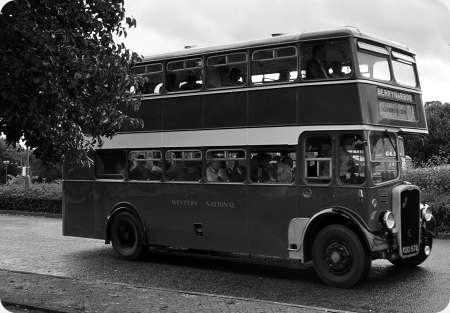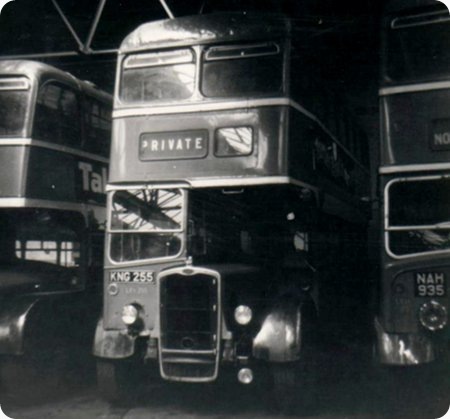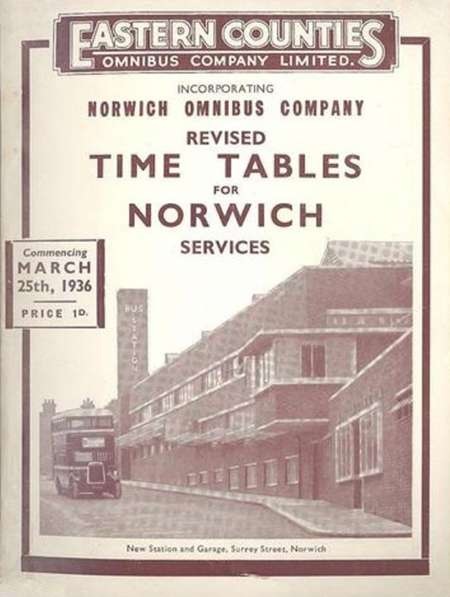
Photograph by ‘unknown’ if you took this photo please go to the copyright page.
York – West Yorkshire Road Car Company
1939
Bristol K5G
ECW H30/26 re-bodied H28/28R in 1955
This bus is not what it seems as it started life as a 1939 Bristol K5G with ECW H30/26 body, numbered Y 702 (YDG 72) and registered DWU 995. A previous posting shows one of these buses of this batch (Y 706) in original condition in York. Re-numbered as YDG 88, this bus is seen in “new” condition in York in 1955.
West Yorkshire decided on a major rebuild of the K5G chassis which included new side frames and re-registering for this last tranche of eleven buses that were re-bodied by the ECW. These buses were 26ft long so the ECW body which was of the style to fit the 27 ft Bristol KS chassis was shortened. This is evident by the reduced width of the front side cab window and also the upper saloon side front windows. I believe similar ECW bodies were supplied to Brighton, Hove and District for their re-bodied ex London Transport Bristol K6As in 1954/55.
The re-registering the chassis was not the usual practice by West Yorkshire as many of their single decker Bristol J chassis received new side frames in the period 1946/47 when their bodies were rebuilt but kept the same registrations as did all the earlier 1937/38 prewar re-bodied Bristol K5Gs. Maybe someone can explain the policy of when to re-register a chassis. I wonder whether the York residents thought YDG 88 was a new bus as I think the Gardner 5LW engine was still rigidly mounted so a loud noise and vibration would be evident for the passengers.
Photograph and Copy contributed by Richard Fieldhouse
A full list of Bristol codes can be seen here.
A full list of West Yorkshire codes can be seen here.
———
21/08/11 – 16:24
A most fascinating resume of this particular batch of rebuilds – I wonder if the method used to "get rid of" the extra 12 inches of the more modern bodywork caused any degree of cramping in the cab – I imagine it must have done. The destination blind brings back far more recent memories for me of my days helping out willingly at Selby Depot for Caldaire/British Bus/Cowie/Arriva. Our normal York services were to Leeds, Doncaster, Goole or Pontefract, but unexpectedly an evening service (409) was commenced from Piccadilly to Fulford Broadway – un-necessary, and competition gone mad !!
Chris Youhill
———
22/08/11 – 07:45
Chris, the KS had a longer bonnet with the front bulkhead set back a bit to accommodate the Gardner 6LW engine, hence the greater length of the cab. I imagine that the rebuilt body on the K5G and K6A would have retained the original cab dimensions of those models. A similar situation existed with the Guy Arab III, which had the extra length for a 6LW in the "snout", whereas the Arab IV had the bulkhead repositioned slightly further back to avoid feature of the projecting radiator.
Roger Cox
———
23/08/11 – 10:02
It’s been something of a puzzle to many why this particular batch of West Yorkshire K-type ‘rehabs’ was re-registered Richard. When their prewar chassis were overhauled at WY Central Works, they were rebuilt with new chassis side members, and all other major units and components were overhauled, and refitted to the chassis. New PV2 radiators were also fitted, to give a more modern appearance. As you say, earlier batches of WY K-types similarly treated were not re-registered. Whether the ‘Yorkies’ also had new cross-members and outriggers fitted to the chassis on overhaul I do not know, but it may be a possibility and thus the chassis could have been deemed to be ‘new’ and re-registered?
In John F Gill’s informative ‘History of York-West Yorkshire’ the author states that the JOC decided that YDG66-76 "should be rebuilt with new chassis utilising the original running units and fitted with new bodies at the approximate cost of £2500 per vehicle, and that if possible the vehicles should be re-registered". Later in the text John mentions that the old bodies had been removed and scrapped at Harrogate, new chassis parts fitted at WY’s Central Works costing £272, and the new ECW bodies cost £1077 each. Presumably labour and other costs would have then taken the figure nearer to the aforementioned £2500. All fascinating stuff, but which also begs the question – why was the batch also renumbered following rebuild to become YDG82-92? What handsome machines though, and very ‘York’. The lack of adverts on YDG88 also shows up the shine of the hand-painted coachwork a treat. Very nice!
Brendan Smith
———
23/08/11 – 14:13
Reregistration of rebuilds seems to be a complex subject. Yorkshire Traction, Yorkshire Woollen and County Motors all rebodied Leyland PS2s as double deckers, as they had a surplus of single deckers. While the YWD ones kept the registrations of the original chassis those in the YTC fleet were given marks contemporary with the new bodies. Presumably Dewsbury CBC was not willing to reregister these rebuilt vehicles but Barnsley was.
County tried to give theirs new registrations but Huddersfield CBC would not allow it so they were transferred to YTC and reregistered by Barnsley.
Bristol Tramways rebuilt some early 1930s B types with L type chassis in 1949 and the wartime bodies were lengthened. Later they were given 1949 bodies yet they always retained the 1930s registrations. This was to get round limits on the number of new chassis Bristol could build after nationalisation by classifying these as rebuilds, including retaining the B chassis number with an L suffix.
Geoff Kerr
———
24/08/11 – 08:19
One aspect which has gone unnoticed/unmentioned is the the whole range of the DG index was a Gloucestershire registration mark!
Chris Hebbron
———
24/08/11 – 10:30
Chris H I spotted that but after reading the first posting again, I think that was a fleet number rather than the registration as it quote a different one..
Quote "This bus is not what it seems as it started life as a 1939 Bristol K5G with ECW H30/26 body, numbered Y 702 (YDG 72) and registered DWU 995. A previous posting shows one of these buses of this batch (Y 706) in original condition in York. Re-numbered as YDG 88, this bus is seen in “new” condition in York in 1955."
I was puzzled by the Gloucestershire link as well!
Richard Leaman
———
24/08/11 – 20:48
You’re right, Richard. For example, I was thinking the reference Y702 was the fleet number, followed by the reg’n mark, whereas it was the body, then fleet number. Silly me!
Chris Hebbron
———
24/08/11 – 20:50
YDG is the fleet number! Was I dreaming again? What this has to do with Gloucestershire registration marks I do not follow! YDG stands for York..double deck..Gardner.
This is a wonderfully evocative post, and a super photograph. What I would give to hear the wonderful sounds they made just once more!
I have been attempting to research which other Tilling fleets had this short style of KS body apart from York. Brighton H and D rebodied their ex London Bs to this style, and Hants and Dorset also rebodied some Ks to this style, some open top.
Something tells me there were others. Please can anyone advise?
John Whitaker
———
25/08/11 – 07:07
That is a very interesting question John W, something which has intrigued me, not so much who had them but how the final outcome was determined. It shows, in a way, that the Bristol K could have had a four bay body all along but of course they didn’t really come into vogue until the late 1940’s and ECW hadn’t designed such a thing until the advent of the KS. When other chassis makes arrived for rebodying, however, the five bay style was usually retained, I’m thinking of Guy Arabs and an AEC Regent for Midland General in 1955 and Guy Arabs, Leyland PD1’s and Albions for Scottish companies. Were former Tilling companies able to state any requirements or was it entirely down to the drawing office at Lowestoft, or were other factors involved?
Chris Barker
———
26/08/11 – 06:55
Very intriguing Chris, I agree. Perhaps the nationalised ownership had something to do with it in that Bristols, the "official" make, could be rebuilt with a "modern" look, whereas non Bristols did not matter in the same way, even if under BTC control as was Mansfield.
In the case of York-West Yorkshire, I strongly suspect that these vehicles were presented to the public as new, which, in a way, they were, but just re-using reconditioned running units. Bristol may have had a stock of obsolescent K chassis frames, with no sales potential due to the KS(W), and LD being the vogue. It would perhaps have been difficult also to fit KS frames, as other mitigating circumstances would apply, such as prop shaft lengths etc. I am pretty sure that the Brighton and Hants and Dorset rebodies retained original chassis frames, as they were not re registered , but I am open to correction as always!
John Whitaker
———
26/08/11 – 06:56
Chris, ECW did build a batch of twelve experimental 4-bay bodies on K-type chassis in 1948/49, and one actually went to York-West Yorkshire (YDB73). Brighton Hove & District and Bristol also received one each, with Eastern Counties taking the remaining nine. An ex-ECOC example was stored at West Yorkshire’s Grove Park depot in Harrogate for a while in the 1980’s. It looked in need of a lot of love and attention, and I don’t know who owned it or what happened to it, but hope such a rare vehicle survived into preservation. The body did look a bit ‘odd’ though, as it was of full four-bay construction rather than four-and-a-quarter. The overall outline was of a standard highbridge ECW body of the period, but with the main side windows ‘stretched’ lengthways. Front and rear upper deck side windows remained short in length however, as on a standard K-type body. This, and the lack of a quarter window or panel ahead of the rear platform looked decidedly strange, and the later 4-bay design used on the KS/KSW chassis looked to me, a more balanced and happier design.
Brendan Smith
———
26/08/11 – 14:35
I have always loved the ECW high-bridge special four and a quarter bay body built on the Bristol K chassis 1954 /55. I bought the photo of YDG 88 posted above on a West Yorkshire Information Service Tour in 1956 and now sharing it with others has brought a great deal of information about these lovely Bristol K5G buses. I believe there were only 27 of these special bodies built. Brighton had 6, Hants & Dorset had 10 and York West Yorkshire had 11 and all were re bodies. If anybody has further information of more than the 27 I have listed, please submit a comment.
Richard Fieldhouse
———
27/08/11 – 07:27
Quoting John above..
" Bristol may have had a stock of obsolescent K chassis frames, with no sales potential due to the KS(W), and LD being the vogue."
I used to live very near to the Bristol Commercial Vehicle works (Motor Constructional Works if preferred!) and when riding my three wheeler bike past the open yard, even then I saw that piles of brake drums, axle assemblies, chassis rails, steering components etc. etc, were left just lying outside on a patch of ground right next to the main Bath Road and completely unprotected except for the silver paint! No railings, no fence, no security and left there for years! Selecting parts for one off designs would have not been any problem!
Try doing that now and keeping them there overnight would be a challenge. Different days!
Richard Leaman
———
30/08/11 – 08:01
That indeed would explain it Richard! Piles of chassis frames etc at the Bristol works when you passed on your bike. We used to make similar excursions on our bikes around various depots and scrap yards in the Bradford area. Times have changed as you say!
Perhaps new chassis sides were fitted to the H & D and B H & D rebodies, even if not re-registered.
There were no lowbridge equivalents as far as I can see, and it was about this time when H and D had some K chassis rebodied with lowbridge ECW bodies built to the original 5 bay style, some, I believe, as "8 footers"
All detailed in ECW Part 2, a book I have unfortunately mislaid!
John Whitaker




